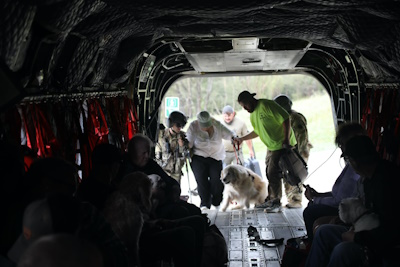In his continued attack on the federal response to Hurricane Helene, former President Donald Trump falsely said that no helicopters and no help were sent to the affected areas for days, blaming Vice President Kamala Harris. There’s plenty of evidence that helicopters have been used and that federal, state and local disaster recovery teams have responded to help victims of the storm.

On Sept. 29, for example, the Army National Guard said that thousands of Guard members had rescued hundreds of people, including with helicopters, and cleared roads in the several states impacted by the hurricane.
Trump, who is making hurricane response misinformation part of his pitch to voters in the last weeks of the presidential campaign, said at an Oct. 9 rally in Reading, Pennsylvania: “While families desperately tried to escape the rising floodwaters and they climbed onto roofs, they did anything they can to live, but Kamala didn’t send any helicopters to rescue them. And when people sent helicopters, they turned them back. … . So she didn’t send anything or anyone at all. Days passed, no help, as men, women and children drowned.”
It was a more colorful version of what he said in Butler, Pennsylvania, on Oct. 5. “Kamala wined and dined in San Francisco,” he said, referring to a Sept. 28 campaign fundraiser Harris attended in the city, “and all of the people in North Carolina — no helicopters, no rescue.” (He went on to falsely suggest, as we wrote, that people whose homes were destroyed would only get $750.)
We asked the Trump campaign to explain what he was referring to when claiming there were no helicopters or help, and that helicopters were turned away, but we didn’t get a response. It appears he’s ignoring the National Guard and FEMA resources and speaking only about the deployment of active-duty troops, a deployment that governors request.
Hurricane Helene made landfall on Florida’s Gulf Coast late on Sept. 26 and rain from the tropical storm subsequently caused severe flooding and widespread damage to parts of North Carolina, South Carolina, Georgia, Tennessee and Virginia.
As we said, the Army National Guard reported that thousands of Guard members — more than 6,600 from 17 states — were engaged in recovery efforts, as of Sept. 29. The Guard press release listed details about the personnel deployed and the actions taken in various states. Specifically in North Carolina, which Trump mentioned and which experienced catastrophic flooding in the western area of the state in the Blue Ridge Mountains, more than 900 Guard members, including some from 11 other states, “cleared roads, transported commodities and conducted search and rescue missions with helicopters,” the Guard said. More than 100,000 pounds of food and other supplies were delivered to the Asheville airport by military cargo plane.
On Sept. 28, the state of North Carolina said that search and rescue operations had been ongoing in the western part of the state. “More than 200 people have been rescued from flood waters in North Carolina following Helene’s torrential rains,” the governor’s office said in a press release, adding that the state’s “search and rescue teams are being bolstered by teams from 19 states and three federal teams.”

A Washington Post reporter wrote about flying on Oct. 2 with a North Carolina National Guard Black Hawk crew that had been flying “for several days straight” as part of recovery efforts. “The drone of helicopters has become routine across western North Carolina in the wake of Helene,” the story said. “National Guard and civilian aircraft now crisscross the skies of a region where roads and bridges have been destroyed and people are trapped.”
The following day, the state National Guard said it had completed “146 flight missions, resulting in the rescue of 538 people and 150 pets.”
In Tennessee, “service members from the 1-230th Assault Helicopter Battalion, based at Knoxville’s Joint Base McGhee-Tyson and Nashville’s Berry Field, have rescued over 100 people and transported over 34,000 pounds of drinking water, food, generators and other equipment to those in need,” according to the Guard’s Sept. 29 press release.
Thousands of federal employees were working on response efforts, the Federal Emergency Management Agency said in a Sept. 30 release, the day that FEMA Administrator Deanne Criswell visited North Carolina. “More than 3,500 personnel from across the federal workforce are deployed and supporting Hurricane Helene response efforts across the impacted states – more than 1,000 are from FEMA,” it said.
The press release listed the amount of food, water, generators, ambulances, Starlink satellite systems and other supplies that had been sent to affected areas. In North Carolina, it said, there were 10 search and rescue teams “on the ground,” with another nine teams arriving that day. In Knoxville, Tennessee, there were about 90 federal Urban Search & Rescue personnel. The release listed other ways that federal, state and local officials, as well as volunteer groups such as the American Red Cross and private sector partners were supporting the efforts. “The Department of Defense has 30 high-water trucks ready to assist rescuers and 18 helicopters that can transport supplies, equipment and teams,” it said.
In a Sept. 30 briefing, Defense Department spokesperson Sabrina Singh also spoke of the “multi-state, multi-agency effort” involving National Guard members. She said that “a team for command and control for high water vehicles and air operations support for rotary wing aircraft has been established at Fort Liberty, North Carolina,” mentioning the helicopters would be there that day and the high-water vehicles were at Fort Campbell.
As for active-duty troops, governors request such deployments through FEMA.
“Governors are in charge of the response in their state, not FEMA or DoD,” Craig Fugate, FEMA administrator during President Barack Obama’s administration and previously director of the Florida Division of Emergency Management, told us in an email. “As to activating Troops on Federal Duty (10 Title 10), that request comes from the Governor for support to FEMA.” FEMA can then ask the Defense Department, “if FEMA has no other way to meet the requirement,” and the Defense Department makes the determination of what it can do and assigns the mission to U.S. Northern Command, which coordinates with FEMA on the deployments.
Fugate noted that the National Guard’s role in disaster response is critical.
In Reading, Trump also said, “It took six days before Kamala and Joe sent a small number of troops to help.” That echoes a claim his running mate, Sen. JD Vance, made in an Oct. 8 Wall Street Journal op-ed, which didn’t mention the National Guard, but said: “On Oct. 2, six days after the storm made landfall, the Defense Department announced that 1,000 troops had been authorized to deploy to the hurricane-response zone, including elements of the 82nd Airborne Division from Fort Liberty, N.C.”
The linked press release, from North Carolina’s governor, Roy Cooper, a Democrat, said that President Joe Biden had approved Cooper’s request for the active-duty troops and equipment. Vance claimed there had been “a bureaucratic bottleneck” that delayed the troops being approved or sent.
We can’t determine whether there was an unnecessary delay. When we asked Cooper’s office about the claim, Jordan Monaghan, deputy communications director for the governor, said in a statement: “Governor Cooper asked President Biden on Monday September 30 to make all necessary federal resources available to respond to this catastrophic storm. Also on September 30, the Governor requested that the Department of Defense approve Brigadier General Charles W. Morrison, North Carolina Army National Guard, as the Dual Status Commander for any active-duty military assigned duty in North Carolina under Title X.”
A dual status commander can serve in federal and state statuses at the same time.
“The Department of Defense approved this request on Wednesday, October 2 and the National Guard and active duty forces began a coordinated deployment into impacted counties,” Monaghan said. “Title 10 aviation assets and including helicopters and pilots deployed almost immediately on October 2 and 3 and 1,500 active duty military personnel have deployed to western North Carolina since October 3, with more on the way.”
We asked Monaghan to clarify whether Cooper requested the active-duty troops on Sept. 30 as well, but we haven’t received a response.
At an Oct. 10 Pentagon press briefing, Press Secretary Maj. Gen. Pat Ryder was asked when the FEMA request came in to the Defense Department for the active-duty troops for North Carolina. He said he didn’t have the dates, but, “I do know that we obviously responded very quickly after receiving the request.”
Monaghan also said: “This is a massive response involving equipment and thousands of personnel from the National Guard, US Army, state and local first responders and emergency managers, FEMA and others. It must be closely coordinated to meet immediate emergency needs and establish a long-term recovery. Every effort is being made to maximize speed, coordination and impact of resources and personnel at every level, and Governor Cooper appreciates the significant additional capabilities brought to this effort by our Active duty forces.”
He said that disinformation online and from Trump and other politicians was a “significant hurdle” in the disaster response.
Trump is free to criticize the Biden administration, of course, but claiming there were “no helicopters” or help for victims of the storm in North Carolina is false. And pointing to the deployment of active-duty troops ignores the large role of the National Guard and federal resources other than the U.S. military.
Editor’s note: FactCheck.org does not accept advertising. We rely on grants and individual donations from people like you. Please consider a donation. Credit card donations may be made through our “Donate” page. If you prefer to give by check, send to: FactCheck.org, Annenberg Public Policy Center, P.O. Box 58100, Philadelphia, PA 19102.